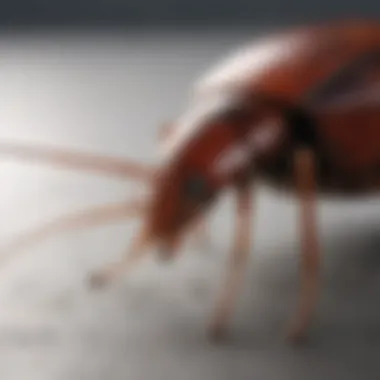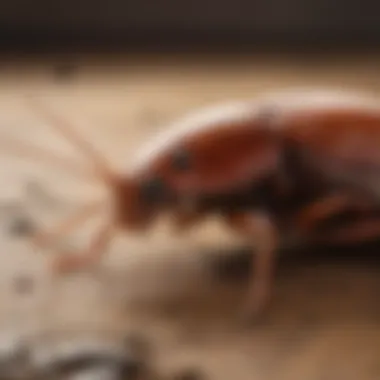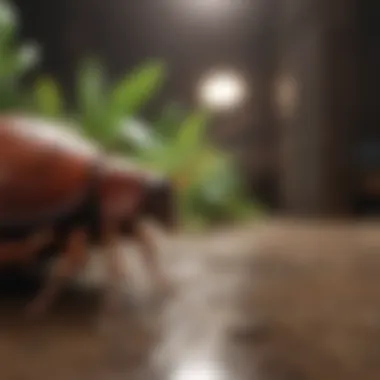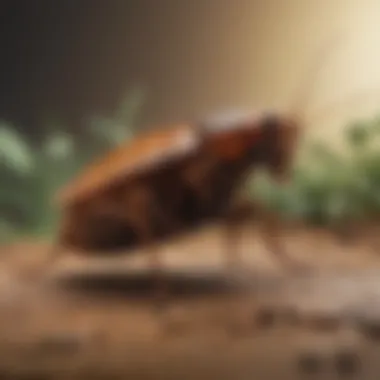Effective Strategies for a Pest-Free Environment: The Ultimate Guide to Eliminating Cockroaches


Animal Species Profile Cockroaches are a common household pest that thrive in warm and humid conditions. They are characterized by their flat bodies and long antennae, typically ranging in size from half an inch to two inches in length, depending on the species. These pests are known for their rapid movement and nocturnal habits. Cockroaches can be found worldwide, particularly in areas where food and water sources are abundant. They are highly adaptable insects, capable of surviving in a variety of environments, from residential homes to commercial establishments.
Effective Strategies for Eliminating Cockroaches When dealing with a cockroach infestation, it is essential to understand their behavior and habits to effectively eliminate them from your living space. One of the most crucial steps in pest control is to keep your home clean and free of food crumbs or spills that may attract these pests. Sealing cracks and crevices around your home can help prevent them from entering. Using baits, traps, and insecticides can be effective in reducing cockroach populations. It is also advisable to seek professional pest control services for severe infestations. By implementing a comprehensive approach that includes sanitation, exclusion, and treatment, you can achieve a pest-free environment and prevent future infestations.
Understanding Cockroaches
In this article, the understanding of cockroaches plays a crucial role in devising effective strategies for a pest-free environment. By delving into the specifics of these resilient pests, individuals can better grasp the habits, behaviors, and types of cockroaches commonly found in living spaces. Understanding the intricacies of cockroach infestations empowers individuals to implement targeted eradication methods, from preventive measures to professional extermination services, ensuring a comprehensive approach to pest control.
Identifying Common Types of Cockroaches
German Cockroaches
German cockroaches, a prevalent species in urban areas, pose a significant challenge for pest control efforts due to their rapid reproduction rates and adaptable nature. These small, light brown cockroaches are known for their tendency to hide in cracks and crevices, making them difficult to eliminate. While their size may be a disadvantage, their resilience and wide distribution make them a crucial focus in the battle against cockroach infestations.
American Cockroaches
American cockroaches, also known as palmetto bugs, are one of the largest cockroach species, often found in dark, damp areas like basements and sewers. With their reddish-brown color and distinctive yellow figure-eight pattern on their pronotum, these cockroaches are hardy insects capable of surviving in various environments. Despite their outdoor habitat preference, American cockroaches can find their way indoors, posing hygiene and health risks to residents.
Oriental Cockroaches
Oriental cockroaches, commonly referred to as water bugs, thrive in humid and dark environments, such as crawl spaces and drainage systems. These dark-colored insects emit a characteristic musty odor and are notorious for their slow reproductive cycle. While Oriental cockroaches prefer colder temperatures compared to other species, they can still infest residential properties, requiring stringent control measures to prevent their spread.
Brown-Banded Cockroaches
Brown-banded cockroaches, named for the light bands across their wings, are smaller in size compared to other species but equally resilient in survival. These agile insects prefer warm, dry locations like bedrooms and living rooms, where they can feed on various organic materials. With their ability to infest multiple rooms in a single dwelling, brown-banded cockroaches demand immediate attention and targeted extermination efforts to prevent further population growth.
Habits and Behavior of Cockroaches
Nocturnal Nature
The nocturnal nature of cockroaches serves as a survival strategy, allowing them to forage for food undisturbed during the night. This behavior is a key adaptation that has enabled cockroaches to thrive in human habitats, taking advantage of the darkness to scavenge for sustenance without interference. While their nocturnal habits make them challenging to detect during the day, implementing proactive monitoring measures can aid in identifying and addressing infestations promptly.
Feeding Patterns
Cockroaches possess versatile feeding patterns, consuming a wide range of organic matter, including crumbs, grease, and even glue. Their scavenging behavior enables them to adapt to various environments, making them resilient pests capable of surviving on minimal food sources. Understanding their feeding preferences is essential for implementing effective baiting and trapping strategies to lure and eliminate cockroach populations effectively.
Preferred Habitats
Cockroaches seek out warm, moist environments with access to food and water sources, making kitchens, bathrooms, and basements prime habitats for infestation. Their attraction to these areas stems from the abundance of shelter and sustenance, creating ideal conditions for reproductive success. By identifying and addressing conducive conditions in these preferred habitats, individuals can disrupt cockroach breeding cycles and limit infestation risks in residential spaces, promoting a healthier living environment.


Preventive Measures
Preventive measures play a crucial role in maintaining a pest-free environment. By implementing proactive strategies, you can effectively deter cockroaches from infesting your living space. Regular cleaning practices are essential in eliminating potential food sources that attract cockroaches. Ensuring proper food storage not only prevents access to food but also minimizes the chances of an infestation. Additionally, sealing cracks and crevices acts as a barrier, restricting the entry points for cockroaches into your home.
Maintaining Cleanliness
Regular Cleaning Practices
Regular cleaning practices encompass vacuuming, sweeping, and disinfecting surfaces to eradicate crumbs and spills that cockroaches feed on. The meticulous removal of food residue and maintaining a sanitary environment is key to deterring cockroaches. This practice significantly reduces the chances of attracting these pests, contributing to a pest-free home.
Proper Food Storage
Proper food storage involves using airtight containers to store food items, preventing cockroaches from accessing potential food sources. This method not only preserves the freshness of food but also deters pests from contaminating it. By storing food properly, you eliminate the enticing smells that may attract cockroaches, thus safeguarding your home from infestations.
Sealing Cracks and Crevices
Sealing cracks and crevices with sealants or caulk is imperative in blocking cockroach entry points. By addressing openings in walls, floors, and windows, you create a barrier that inhibits cockroach intrusion. This proactive measure prevents these pests from finding shelter or breeding in hidden areas, reducing the likelihood of an infestation.
Eliminating Moisture Sources
Fixing Leaks
Addressing plumbing leaks and sources of moisture is vital in cockroach prevention. Fixing leaks not only reduces water availability, which attracts cockroaches, but also mitigates the risk of mold growth. By promptly repairing leaks, you eliminate conducive conditions for cockroaches and discourage their presence in your home.
Ventilating Damp Areas
Proper ventilation in damp areas like bathrooms and kitchens limits moisture accumulation, creating an inhospitable environment for cockroaches. Adequate airflow aids in drying wet surfaces, preventing the persistent dampness that attracts these pests. By ventilating damp areas, you hinder cockroach sustenance and reproduction, contributing to a pest-free household.
Drying Wet Surfaces
Thoroughly drying wet surfaces, such as sinks, countertops, and bathtubs, is essential to deter cockroach infestations. By removing excess moisture through drying, you eliminate water reservoirs that cockroaches rely on for survival. This practice disrupts their breeding and foraging patterns, making your home less inviting to these resilient pests.
Home Remedies and Natural Solutions
In the quest to create a pest-free environment, turning to home remedies and natural solutions plays a crucial role. These alternatives offer a safe and eco-friendly approach to tackling cockroach infestations without the use of harmful chemicals. By incorporating DIY methods using common household items, individuals can effectively control and eliminate cockroaches while minimizing the impact on the environment and other non-target species. Home remedies and natural solutions not only provide a cost-effective option but also promote sustainable pest management practices, making them a preferred choice for those seeking gentle yet comprehensive solutions.
DIY Cockroach Repellents
Boric Acid:
Boric acid is a versatile and go-to solution for cockroach control due to its potency in eradicating these pests. Its abrasive properties not only damage the exoskeleton of cockroaches but also dehydrate them, leading to their demise. This white powdery substance adheres to the cockroach's body, eventually proving fatal. Boric acid is highly effective when strategically placed in areas of cockroach activity, making it a popular choice for long-term pest management strategies. While boric acid is potent against cockroaches, precautions must be taken to prevent direct contact with humans and pets due to its toxicity.


Peppermint Oil:
Peppermint oil serves as a natural cockroach repellent, emitting a strong aroma that deters these pests from inhabiting specific areas. Its pleasant smell is well-received by humans but repels cockroaches due to its overwhelming nature. When applied in commonly infested areas, peppermint oil disrupts the cockroach's pheromone trails, hindering their movement and communication. This botanical solution not only repels cockroaches but also serves as an environmentally-friendly alternative to chemical insecticides.
Catnip:
Catnip, a member of the mint family, possesses potent repellent properties against cockroaches. The active compound nepetalactone found in catnip acts as a natural deterrent for cockroaches, causing them to avoid areas where catnip is present. By strategically placing catnip in key locations, individuals can disrupt the cockroach's navigation and feeding patterns, leading to their eventual avoidance and departure. Although catnip is highly effective in repelling cockroaches, its utilization should be cautious around feline companions who may exhibit a strong attraction to this herb.
Essential Oils for Cockroach Control
Lavender Oil:
Lavender oil, renowned for its calming aroma, also serves as a powerful tool in cockroach control. The distinct fragrance of lavender oil not only masks the odors that attract cockroaches but also acts as a repellent that disrupts their sensory mechanisms. Additionally, lavender oil possesses antimicrobial properties, enhancing its effectiveness in maintaining a hygienic environment while deterring cockroach infestations. By incorporating lavender oil into their pest management strategies, individuals can enjoy a fresher living space free from unwanted intruders.
Tea Tree Oil:
Tea tree oil, renowned for its antiseptic and medicinal properties, offers a dual-purpose solution for both disinfection and cockroach control. The potent aroma of tea tree oil overwhelms and repels cockroaches, driving them away from treated areas. Additionally, the antimicrobial properties of tea tree oil contribute to creating an inhospitable environment for cockroaches, reducing the likelihood of infestations. Its natural composition makes it an ideal choice for individuals seeking a non-toxic yet effective approach to combating pest issues.
Citrus Oil:
Citrus oil, derived from citrus fruits such as oranges and lemons, serves as a versatile cockroach repellent due to its high concentration of limonene—a compound known for its insecticidal properties. The strong citrus aroma not only masks the scents that attract cockroaches but also disrupts their chemical signals, confusing their navigation and communication. By incorporating citrus oil into their pest control regimen, individuals can create an unfavorable environment for cockroaches while enjoying the pleasant fragrance of citrus fruits.
Chemical Treatments
When it comes to dealing with cockroach infestations, chemical treatments play a crucial role in effectively eradicating these resilient pests. Chemical treatments offer a potent and targeted approach to eliminating roaches from your living space. By employing the right chemicals, you can effectively disrupt the roaches' reproductive cycle and habitat, ensuring long-term pest control. However, it is vital to exercise caution and follow safety guidelines when using chemical treatments to mitigate any risks to humans and pets. Before application, it is recommended to identify the specific type of cockroach infesting your home to choose the most appropriate chemical treatment for effective results.
Insecticidal Sprays
Insecticidal sprays are a popular choice for combating cockroach infestations due to their quick action and ease of use. They contain active ingredients designed to target and eliminate roaches upon contact. Within this category, various types of insecticidal sprays are commonly used, each with its unique benefits and considerations.
Pyrethroids
Pyrethroids are synthetic compounds derived from natural pyrethrins found in chrysanthemum flowers. They are known for their fast knockdown effect on insects, making them a popular choice for cockroach control. Pyrethroids act by disrupting the roaches' nervous system upon contact, paralyzing and ultimately killing them. While pyrethroids are effective against a wide range of pests, including cockroaches, some drawbacks include potential toxicity to aquatic life and bees.
Neonicotinoids
Neonicotinoids are a class of insecticides that target specific receptors in the nervous system of insects, leading to paralysis and death. They are valued for their systemic action, meaning the insecticide is absorbed by plants, making them toxic to ingesting insects like cockroaches. Neonicotinoids offer long-lasting control and are less harmful to mammals compared to other chemical pesticides. However, their use has raised concerns about their impact on beneficial insects like bees and other pollinators.
Biochemical Insecticides


Biochemical insecticides are derived from natural substances like plants or microorganisms, offering a more environmentally friendly alternative for pest control. These insecticides work by disrupting specific biological processes in insects, leading to their demise. Biochemical insecticides are favored for their minimal impact on non-target organisms and reduced harm to the environment. However, they may require repeated applications for effective cockroach control.
Bait Stations and Gel Baits
In addition to insecticidal sprays, bait stations and gel baits are commonly employed as chemical treatments for cockroach elimination. These products offer a strategic approach to targeting roaches in their habitats and are designed for both indoor and outdoor use.
How They Work
Bait stations and gel baits function by attracting roaches with a bait containing a lethal pesticide. Roaches are drawn to the bait, consume it, and then transport it back to their nests, where it is shared with other roaches, ultimately leading to widespread elimination. This method effectively targets roaches at their source, reducing the population over time.
Best Practices for Application
When using bait stations and gel baits, it is essential to place them in areas frequented by cockroaches, such as near food sources, water outlets, and hiding spots. Regularly monitor and replenish the baits to maintain their potency and ensure continuous roach control. Follow the manufacturer's instructions carefully to maximize the effectiveness of bait stations and gel baits while minimizing potential risks to non-target organisms and pets.
Professional Extermination Services
Professional extermination services play a crucial role in the battle against cockroach infestations. These services provide in-depth expertise, specialized equipment, and potent treatments that are necessary for eradicating persistent roach populations effectively. By enlisting the aid of professional exterminators, individuals can ensure a thorough and comprehensive approach to tackling these resilient pests. Experts in the field of pest control are equipped to handle infestations of any size, from minor nuisances to severe infiltrations, offering tailored solutions for each unique situation.
Professional extermination services offer several key benefits that make them indispensable in the fight against cockroaches. Firstly, their extensive knowledge of cockroach behavior and biology enables them to identify the root causes of infestations and implement targeted strategies for eradication. Additionally, these services utilize advanced tools and high-quality products that are not readily available to the general public, ensuring thorough and long-lasting results. Moreover, professional exterminators follow strict safety protocols to protect both residents and the environment while effectively eliminating cockroaches.
When faced with severe infestations of cockroaches, seeking professional help is essential for bringing the situation under control. Severe infestations are characterized by a large number of roaches present in the living space, visible signs of damage, persistent sightings even after DIY treatments, and a pervasive foul odor. These infestations pose significant health risks and can quickly escalate if not addressed promptly. Professional exterminators are equipped to handle such severe cases efficiently, utilizing potent insecticides and targeted treatments to eradicate cockroaches at all life stages.
On the other hand, persistent cockroach problems refer to recurring infestations that continue to resurface despite repeated efforts to eliminate them. This scenario indicates underlying issues that need to be addressed comprehensively to prevent future outbreaks. Persistent cockroach problems often stem from hidden nesting sites, inadequate sanitation practices, or external sources of infestation. Professional exterminators excel in identifying these underlying causes and developing customized strategies to break the cycle of infestations, ensuring long-term relief for residents.
Maintaining a Cockroach-Free Environment
In this article, delving into the topic of Maintaining a Cockroach-Free Environment is crucial for ensuring a pest-free living space. By focusing on Regular Inspections and Monitoring, individuals can proactively address any potential cockroach infestations and take necessary actions to prevent them from spreading. It is essential to prioritize this aspect as part of an overall pest control strategy, as early detection can significantly impact the effectiveness of pest elimination efforts.
Regular Inspections and Monitoring (250-300 words)
Signs of Cockroach Activity
When considering Signs of Cockroach Activity, it is vital to understand the specific indicators that signal the presence of these resilient pests in your home. These signs may include feces, egg casings, musty odors, or even seeing live cockroaches scurrying around during nighttime. Recognizing these signs promptly is crucial for swift intervention and can prevent a minor issue from escalating into a full-blown infestation. Regularly checking common hiding spots such as dark corners, behind appliances, and within cracks and crevices can aid in early detection, allowing homeowners to take immediate action to address the problem.
Monitoring Techniques
Effective Monitoring Techniques play a pivotal role in gauging the extent of a cockroach infestation and tracking the success of eradication measures. By employing methods like sticky traps, bait stations, and visual inspections, individuals can gain valuable insights into cockroach population trends and behavior patterns. These techniques not only help in identifying problem areas but also aid in evaluating the efficiency of implemented control measures. Adopting a proactive approach to monitoring ensures that any resurgence of cockroach activity is promptly identified and dealt with, maintaining a sustainable pest-free environment over the long term.
Sustainable Practices for Long-Term Control (250-300 words)
Integrated Pest Management
Integrated Pest Management (IPM) encompasses a holistic approach to pest control that focuses on prevention, monitoring, and intervention. By integrating various control tactics such as sanitation practices, habitat modification, and biological control methods, IPM aims to address pest issues in a comprehensive and environmentally friendly manner. This strategy not only targets immediate pest problems but also aims to address the underlying causes of infestations, promoting long-term resilience against cockroach invasions. Embracing IPM principles allows homeowners to manage pest populations effectively while minimizing the need for chemical interventions, fostering a balanced and sustainable ecosystem within the home.
Preventive Strategies
Implementing Preventive Strategies forms a cornerstone of cockroach control efforts, emphasizing proactive measures to deter pests before they establish a foothold in the living space. This may involve sealing entry points, reducing clutter, and maintaining proper hygiene practices to eliminate attractants for cockroaches. By creating an inhospitable environment for these unwanted intruders, individuals can significantly reduce the risk of infestations and ensure a long-lasting barrier against future incursions. These preventive measures, coupled with regular monitoring and strategic interventions, help fortify the defense against cockroach infestations and promote a sustainable, pest-free environment for years to come.







